
|
|

December 17, 2010
WHIO Radio and TV, Dayton, OH
Every once in a while, our travel agenda here at Site of the Week is dictated by impending deadlines - if we don't get somewhere to see a particular historic site, it'll soon be gone, and we'll lose the chance to document it.
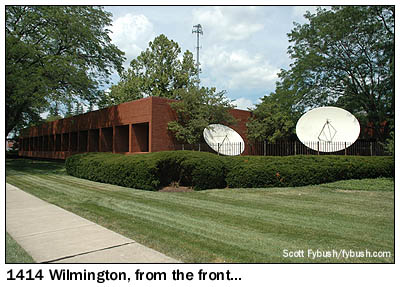 |
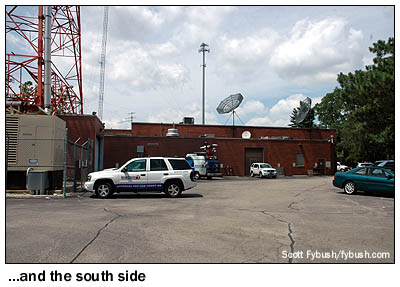
|
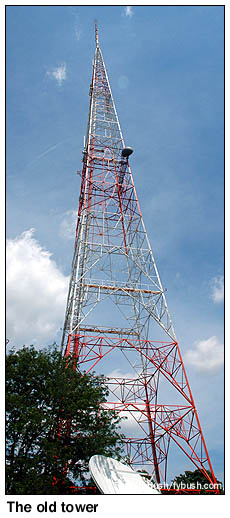 So
it was with a particular piece of our summer 2010 travel schedule:
after many years of trekking in, through and around Dayton, Ohio,
it was "now or never" if we hoped to get a peek inside
the studios of WHIO radio and TV before some big changes came
their way.
So
it was with a particular piece of our summer 2010 travel schedule:
after many years of trekking in, through and around Dayton, Ohio,
it was "now or never" if we hoped to get a peek inside
the studios of WHIO radio and TV before some big changes came
their way.
The WHIO stations, you see, are the flagships of Cox Media Group, which also owns the Dayton Daily News. And after nearly six decades on Wilmington Avenue on the east side of Dayton, the stations were getting ready to move into a newly-synergized "Cox Media Center" facility, sharing space and news resources with the Daily News.
As we planned out our summer travels, then, we knew we'd want to include a stop in Dayton to visit the WHIO facility and document it for posterity.
Later in 2011, we'll show you the rest of our Dayton adventures, which ended up including visits to every commercial TV station in town and still more radio - but this week, we're showing you WHIO, because this week the Wilmington Avenue facility sits empty for the first time in many years, as the WHIO stations settle in to their new Cox Media Center home.
To look at the front of the Wilmington Avenue building, you'd never know the WHIO stations had called this property home since 1949, when WHIO-TV (Channel 13, later moved to channel 7) signed on from a 517-foot self-supporting tower here. Reference books of the era put WHIO-TV's offices in the old Daily News building at 45 South Ludlow Street in downtown Dayton, which had been home to WHIO radio (1290) since Governor Cox put the station on the air in 1935, but the TV studios were located at Wilmington Avenue from the beginning, and we think the radio studios moved out there around the same time.
(WHIO's history actually started in the 1920s in Oil City, Pennsylvania, of all places, at a station called WLBW. In order to get a new radio station in Dayton, Cox had to buy WLBW and move its allocation, then on the pre-NARBA frequency of 1260, to Dayton. Try doing that today!)
The WHIO building on Wilmington Avenue was one of the first purpose-built structures for a TV and radio studio, and it was designed as something of a mirror image. On the north side, a pair of high-ceilinged radio studios sat side by side, looking out to a large master-control area; on the south side, a big TV studio was ready for live productions, and lots of them. And in case radio faded away, as some visionaries predicted it would in the face of newfangled TV, the radio studios could be easily converted into additional TV studios, should they be needed.
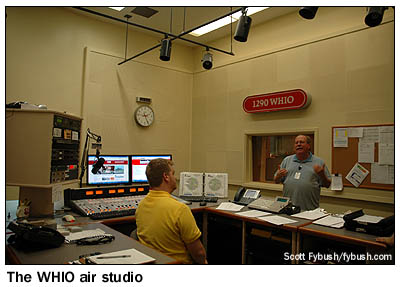 |
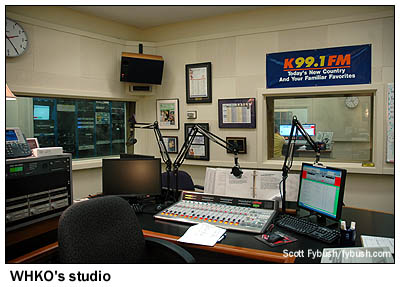 |
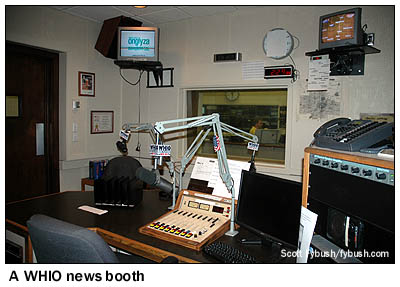 As it
turned out, radio did just fine, thanks. WHIO radio settled in
for a long run as Dayton's full-service voice, while Cox's early
FM entry, WHIO-FM (99.1), became a force in the market in its
own right, first with beautiful music and then, after a 1989
format and call change, as country "K99.1," WHKO.
As it
turned out, radio did just fine, thanks. WHIO radio settled in
for a long run as Dayton's full-service voice, while Cox's early
FM entry, WHIO-FM (99.1), became a force in the market in its
own right, first with beautiful music and then, after a 1989
format and call change, as country "K99.1," WHKO.
Cox added more FM signals, too: the classic rock simulcast of WCLR (95.7 Piqua) and WZLR (95.3 Xenia) joined the family in 1998; they later flipped to 80s pop as "The Point," WDPT/WDTP, and in 2006 the Xenia transmitter went back to being WZLR while the Piqua signal became WHIO-FM, a full-fledged FM simulcast of WHIO(AM)'s news and talk.
By the time we dropped by in July 2010, WHIO and WHKO occupied those two big radio studios at the core of the radio side of the building, but the big windows to the left of the air talent no longer looked out into the radio master control area, as they did in the building's early years. That space had become a rack room, with engineering offices behind it.
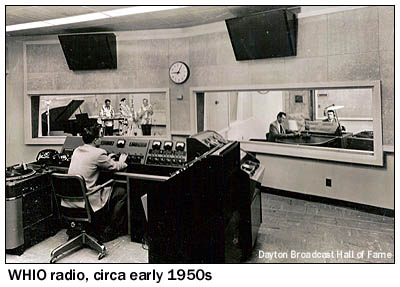 |
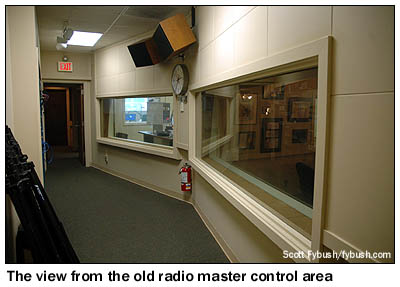
|
The studio with the piano in that view above, circa 1950, had become the WHIO air studio, while the studio on the right had become WHKO; another WHIO studio, used as a news booth and a talk studio, sat behind the main WHIO air studio, complete with heavy doors and vintage "on-air" lights.
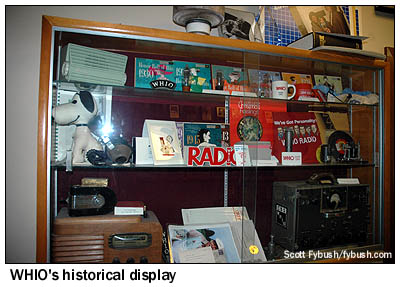 |
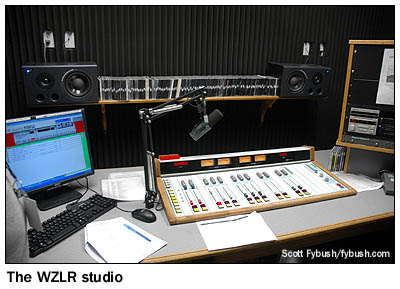
|
Over the years, the Wilmington Avenue building had grown considerably from its original size, which explains why the view from the street, shown at the top of the page, doesn't look anything like a 1949-vintage broadcast facility. (I believe that addition on the front of the building, which housed executive offices and a small lobby, dated to sometime in the early 1980s.)
In later years, visitors to Wilmington Avenue walked past the base of the big self-supporting tower to enter the lobby, which in turn led into a large sales area that I think must have been where the original front entrance to the building was located. From there, a ramp led down past a showcase of WHIO historical material to the original radio studios - and to another corridor lined with more studios. The WZLR studio was back there, as were WHIO's traffic office, radio newsroom and another studio used for news production.
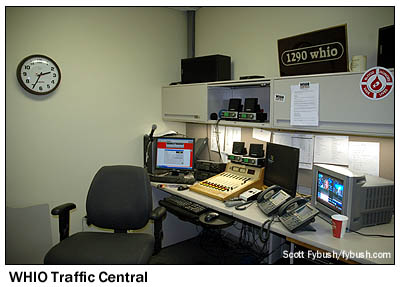 |
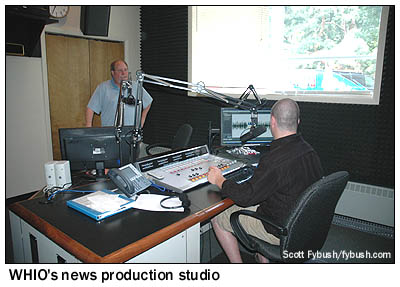
|
Our tour of the WHIO building was largely radio focused, since our tour guide, Kevin Fodor, is the in-house historian for the radio side - but Kevin (who's heard on air as WHIO radio newsman "Jason Michaels") also took us over to the TV side to see how that had evolved over the years.
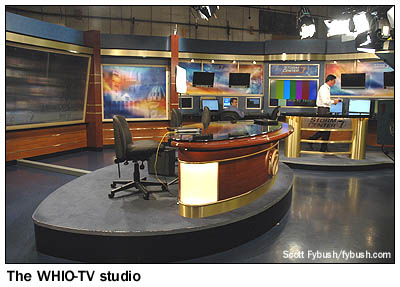 |
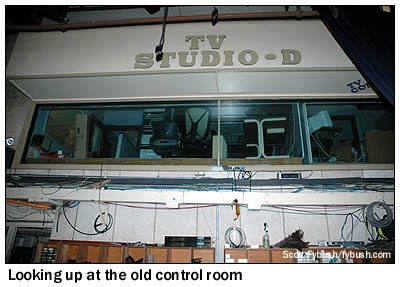
|
The original WHIO-TV studio from 1949 was still in use in 2010, though a corner of it had been walled off for use as a weather office. Back in the 40s and 50s, state-of-the-art TV studio design included a big window that looked down into the studio from the control room, and that window was still visible in WHIO-TV's studio, though much of the space up above had been partitioned off for storage and whatnot.
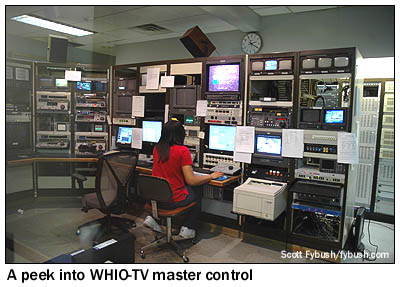 |
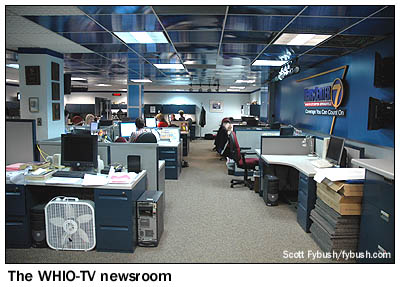
|
From what we saw of WHIO-TV's operations, it was quite cramped in its last years at Wilmington Avenue. Even though the TV transmitter had long since moved away to the new tower farm west of Dayton, other functions had long since grown to fill the space. WHIO-TV's master control was upstairs, in at least some of the space that had been used by the original TV control room; the newsroom was downstairs, in what looked to be rather less space than was needed for the market's top-rated news operation.
That's not a problem in the new WHIO digs; Jason says the new combined radio/TV/newspaper newsroom is huge, and he reports that the staff is settling in quite happily there.
We'll get back to Dayton sometime in 2011 to see the new facility - and by then, we'll have caught up with some of our backlog on Tower Site of the Week, so stay tuned in the new year for more of our Dayton visit, including a look at the WHIO 1290 transmitter site, and much more...
 - Find out when the new Tower Site is posted,
and much more! Follow us on Twitter @NERadioWatch - and don't miss your chance to order the all-new
Tower Site Calendar 2011 at the Fybush.com
store!
- Find out when the new Tower Site is posted,
and much more! Follow us on Twitter @NERadioWatch - and don't miss your chance to order the all-new
Tower Site Calendar 2011 at the Fybush.com
store!- Previous Site of the Week: WCAP, Lowell, MA
- Next Week: KID, Idaho Falls, Idaho
- Site of the Week INDEX!
- How can you help support Site of the Week? Click here!
- Submit your suggestions for a future Site of the Week!

